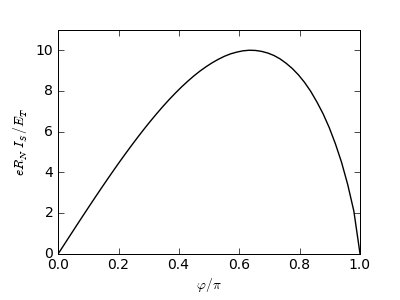
We want to calculate for an SNS junction:
See also
All calculations start with a geometry specification. An SNS junction can be modeled with two S-terminals and one N-wire:
geometry = u.Geometry(nwire=1, nnode=2)
geometry.t_type = [u.NODE_CLEAN_S_TERMINAL, u.NODE_CLEAN_S_TERMINAL]
geometry.w_type = [u.WIRE_TYPE_N]
The wire is connected to both terminals:
geometry.w_ends[0,:] = [0, 1]
Note that all indices are zero-based; the first terminal is 0 and the second 1.
Moreover, currently only clean interface boundary conditions are implemented. In principle, these would be straightforward to add; the place to put them would be in sp_equations.f90.
Then, assign a phase difference and energy gap for the terminals:
geometry.t_delta = [100, 100]
geometry.t_phase = [-.25*pi, .25*pi]
and set wire properties
geometry.w_length = 1
geometry.w_conductance = 1
Next, the spectral equations can be solved, and results saved to a file:
solver = u.CurrentSolver(geometry)
solver.set_tolerance(sp_tol=1e-8)
solver.solve_spectral()
solver.save('sns-spectral.h5')
To capture the SNS junction minigap edge correctly at phase
differences  , we need to set a stricter
tolerance
, we need to set a stricter
tolerance  than the default
than the default  for the
spectral solver. This has an impact on speed, however.
for the
spectral solver. This has an impact on speed, however.
The results can be inspected with any program that can read HDF5 files, for example Matlab (use the supplied scripts/h5load.m script to load HDF5 files), or Python:
a, b = solver.spectral.a, solver.spectral.b
E, x = solver.spectral.E, solver.spectral.x
dos = real((1 + a*b)/(1 - a*b))
The solver object has attributes
spectral, coefficient, kinetic
that contain the solutions (Riccati parameters)  ,
,  to the spectral equations, the kinetic coefficients,
to the spectral equations, the kinetic coefficients,  ,
,
 ,
,  ,
,  , and the solutions to the
kinetic equations,
, and the solutions to the
kinetic equations,  , ,
, ,  . The Green function
is parameterized in a mixed Riccati–distribution function scheme
. The Green function
is parameterized in a mixed Riccati–distribution function scheme


Plot the DOS in the N-wire (lines for different positions are offset from each other):
import matplotlib.pyplot as plt
j = arange(0, 101, 2)
plt.plot(E[:,None] - 0.5*j[None,:], dos[:,0,::2] + 0.08*j[None,:], 'k-')
plt.xlabel('$E/E_T$'); plt.ylabel('$n/n_N$')
plt.ylim(0, 15); plt.xlim(-50, 300)
plt.savefig('dos.eps')

There is the minigap, already reduced by the finite phase difference.
First, we want to switch to a faster solver:
solver.set_solvers(sp_solver=u.SP_SOLVER_TWPBVP)
The default one is u.SP_SOLVER_COLNEW; there are some cases where TWPBVP does not converge, so it is not the default.
Current-phase relation can be calculated as follows:
phi = linspace(0, pi, 50)
I_S = zeros([50])
geometry.t_t = 1e-6 # Zero temperature
for j, p in enumerate(phi):
geometry.t_phase = array([-.5, .5]) * p
solver.solve()
Ic, Ie = solver.get_currents(ix=0)
I_S[j] = Ic[0]
savetxt('sns-I_S.dat', c_[phi, I_S])
What we do here is:
The result is:
plt.clf()
plt.plot(phi/pi, I_S, 'k-')
plt.xlabel(r'$\varphi/\pi$'); plt.ylabel('$e R_N I_S / E_T$')

As we had  , the maximum
, the maximum  does not reach
does not reach
 .
.